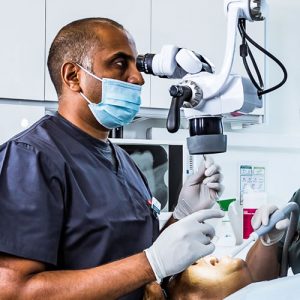Restorative Dentistry – The Root Canal Procedure
What this procedure consists of and why you shouldn’t be afraid of it
 There is little doubt that if you asked someone to name the most painful dental treatment there is, more than 90% would say it was a root canal procedure. There is no real reason why people should believe this but we can only guess that this stems from a time when x-rays were not routinely used.
There is little doubt that if you asked someone to name the most painful dental treatment there is, more than 90% would say it was a root canal procedure. There is no real reason why people should believe this but we can only guess that this stems from a time when x-rays were not routinely used.
When you have a root canal infection, abscesses that are not visible to the naked eye can sometimes, though not always, form. If no x-ray was available, it doesn’t take a lot of imagination to realise how painful it would be if the dentist came into contact with it during a treatment.
Patients of The Dental Centre Bedford need not worry though. X-rays are routinely used when we suspect a problem might lie beneath the gum line where our dentists can’t see with the naked eye. Where an x-ray detects an abscess it will be treated before the root canal procedure is carried out. We also use powerful local anaesthetics of course, but more about this below.
Why might you need root canal treatment?
A tooth consists of three main parts, the hard external enamel that protects our teeth, the dentin layer which lies beneath this and is more porous, and the root canals where tiny blood vessels and the nerves of the tooth are situated. When the enamel becomes damaged, it increases the risk of bacteria entering into the more porous part of the tooth. This is often when tooth decay is detected and in many cases, treated using a dental filling. Sometimes though, the bacteria manages to enter the root canals and, as the nerves are located there, this can be a very painful experience indeed. Once this happens, a filling is not an option and you will require a root canal procedure instead.
The procedure
Your root canal treatment will be performed by an endodontist. This is a specialist dental field and you can be sure that you will be in the best of hands. Once we have determined that there are no abscesses present, or you have previously been treated for one and are now ‘clear’ you will be given a local anaesthetic to minimise any discomfort. Once the procedural area is fully numbed, the endodontist will access the top or side of the tooth. This allows them to reach the root canals where the infection lies. The infected material, including the blood vessels and nerves are then removed manually before a thorough cleaning of the now hollow root canals is carried out to help prevent any recurrence of the infection.
Naturally, the root canals can not be left in this hollow state, but unlike other situations, the filling of the canals is not done using amalgam or tooth coloured filling materials but a special material called Gutta Percha. This is a naturally occurring substance that comes from the Palaquium Gutta tree in Malaysia. It is used for this treatment due to its thermoplastic qualities which allows it to expand when heated. This enables it to reach into all areas of the cavity and seal it against further infection.
Having filled the root canal, it could, technically, be left like this but most often isn’t. If it was left at this stage it would not only look unnatural but would also be significantly weaker than a natural tooth. In most instances, the endodontist will then complete the treatment by attaching a dental crown to complete the procedure. This then leaves you with a natural looking tooth that also offers a good degree of strength.
Cautions and aftercare
One ‘problem’ with a root canal treated tooth is that, with the nerves no longer present, it can be very difficult to judge how hard you are biting down when you use that tooth. We recommend that our Bedford patients avoid using a tooth that has been treated in this way for eating harder foods. Although it will offer sufficient strength for everyday use, it is unlikely to be as strong as a healthy natural tooth and caution should be exercised when eating.
Despite the fact that it is impossible to suffer from toothache as the nerves have now been removed, this doesn’t mean that you shouldn’t take care of it. In addition to the above caution, you should still make sure that you brush and floss the tooth as you would/should your natural teeth. Gum disease is still a risk and neglect of this tooth could still lead to its loss if you don’t take good care of it.
We do understand that some of our patients may still be concerned about this treatment, especially given its unwarranted reputation. We are always happy to discuss any aspect of the treatment with you if you so wish.
Appointments can be made, whether for general dental treatment or cosmetic dentistry by calling The Dental Centre Bedford on 01234 819868.
